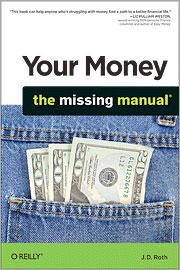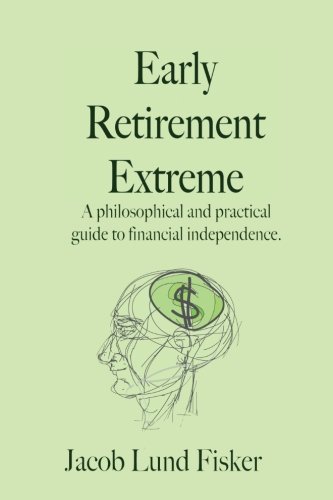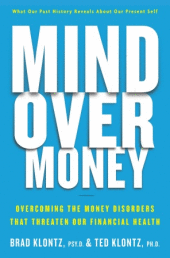The best books about money
In my mind, I write about personal finance books all the time. I certainly read them all the time, and I talk about them with the people I know. But the reality is that I haven’t reviewed many books at Get Rich Slowly during the past couple of years. As a result, I’ve been getting a lot of e-mails asking for book recommendations.
Last weekend, I sat down to organize my office. As part of that, I performed a much-needed purge of my books about money. (And yes, I took them to a used book store so I could get a little bit of cash for them.) As I sorted, I made a list of my favorites, the books I recommend to people again and again. Today, I’m sharing that list.
It’ll probably come as no surprise that most of these books were on the last list I shared (which was 2-1/2 years ago!). Many were on my first list of recommended reading back in 2007. But for this list, I’ve added a few titles and removed a couple of others. These are the financial books I think would be most useful to Get Rich Slowly readers.
As before, these books are grouped into sections, roughly following the financial progression of the average person (from debt to financial independence). I’ve marked my favorite books with a happy star . I’ve linked to the Amazon page for each book, but, as always, I encourage you to borrow the titles that interest you from your public library.
Defeating Debt
For those in the first stage of personal finance, debt reduction is the most important task. I know from experience that this can seem like a long, lonely battle. But others have fought it before, and have lived to document the process. Here are three books that describe different approaches to winning the fight.
The Total Money Makeover by Dave Ramsey — Ramsey is an anti-credit zealot. He made a $4 million fortune by his mid-twenties, and then lost it to bankruptcy. Now he runs a personal finance empire. He takes a lot of criticism for his support of the debt snowball, which he describes in detail here, but the thing is: his methods work. If you’re struggling with debt, there’s no better starting place than this book. Ramsey’s advice is permeated with his Christianity, but you can get a lot out of this book even if you’re not religious. [My review.]
Debt is Slavery by Michael Mihalik — Debt is Slavery is a deceptively simple book. It’s short. Its advice seems basic. And it’s self-published, so how good can it be? Well, I think it’s great. In fact, I found myself wishing that I had written it. Mihalik’s advice is spot-on, and he covers a lot of topics that other authors shy away from, such as the effects of advertising, the weight of possessions, and the soul-sucking misery that comes from a bad job. This book may be short, but it’s sweet. Especially great for recent graduates, I think. [My review.]
How to Get Out of Debt, Stay Out of Debt, and Live Prosperously by Jerrold Mundis — How to Get Out of Debt is built on the principles of Debtors Anonymous, a twelve-step program founded in 1971 to help those who struggle with compulsive debt. Mundis was himself a debtor, and he based this book on his own experience. This isn’t purely theoretical information from the mind of some Wall Street finance whiz who has never struggled; this book contains real tips and real stories from real people. If you’ve tried Dave Ramsey without success, read this. It’s 20 years old, but the information is timeless. [My review.]
Everyday Personal Finance
After you’ve defeated debt, you enter the second stage of personal finance, mastering the everyday habits that allow you to build wealth. The books listed here offer a wide view, discussing many aspects of money. They offer advice about saving, investing, and frugality. They don’t go into much detail about any one subject, but they provide motivation to get started. And that’s what’s most important.
 Your Money: The Missing Manual by J.D. Roth — Wait…I put my own book on the list? You bet. I wrote Your Money: The Missing Manual precisely to be the sort of book I needed when I was struggling with money. I think it’s a great resource, getting to the heart of a broad range of topics. I’m not the only one. In his review, Kevin Kelly (the founder of Wired magazine) wrote, “This is the best user-guide to personal finance I’ve found, and I’ve probably read them all.” I refer to my own book almost daily. No joke. I guess that’s one of the luxuries of writing a book — you can just write the book you want!
Your Money: The Missing Manual by J.D. Roth — Wait…I put my own book on the list? You bet. I wrote Your Money: The Missing Manual precisely to be the sort of book I needed when I was struggling with money. I think it’s a great resource, getting to the heart of a broad range of topics. I’m not the only one. In his review, Kevin Kelly (the founder of Wired magazine) wrote, “This is the best user-guide to personal finance I’ve found, and I’ve probably read them all.” I refer to my own book almost daily. No joke. I guess that’s one of the luxuries of writing a book — you can just write the book you want!
 You Can Negotiate Anything by Herb Cohen — It was a toss-up whether to include this or Negotiating Your Salary [my review]. The latter is outstanding, and I recommend it highly to anyone who is applying for a job or asking for a raise. In the end, though, I chose Herb Cohen’s book because it covers a wider range of topics. And it’s entertaining! By becoming a better negotiator, you’ll not only save (and make) more money, but you’ll also become better at conflict resolution. [My review.]
You Can Negotiate Anything by Herb Cohen — It was a toss-up whether to include this or Negotiating Your Salary [my review]. The latter is outstanding, and I recommend it highly to anyone who is applying for a job or asking for a raise. In the end, though, I chose Herb Cohen’s book because it covers a wider range of topics. And it’s entertaining! By becoming a better negotiator, you’ll not only save (and make) more money, but you’ll also become better at conflict resolution. [My review.]
 Money Without Matrimony by Sheryl Garrett and Debra Neiman — As difficult as marriage and money can be, things are even tougher for unmarried couples, both gay and straight. It’s difficult for these folks to get good advice in a society that’s geared toward married couples. Money Without Matrimony is a great book with sound suggestions. It’s non-judgmental, practical, and packed with advice. If you’re in a committed unmarried relationship, I highly recommend you track down a copy. (This may be difficult: My county library system only has two copies, and the book is out of print. But Amazon has some cheap used copies left.) And to be honest, a lot of the advice here is great even for married couples! [My review.]
Money Without Matrimony by Sheryl Garrett and Debra Neiman — As difficult as marriage and money can be, things are even tougher for unmarried couples, both gay and straight. It’s difficult for these folks to get good advice in a society that’s geared toward married couples. Money Without Matrimony is a great book with sound suggestions. It’s non-judgmental, practical, and packed with advice. If you’re in a committed unmarried relationship, I highly recommend you track down a copy. (This may be difficult: My county library system only has two copies, and the book is out of print. But Amazon has some cheap used copies left.) And to be honest, a lot of the advice here is great even for married couples! [My review.]

All Your Worth: The Ultimate Lifetime Money Plan by Elizabeth Warren and Amelia Warren Tyagi — I didn’t like All Your Worth when I first read it. The book takes a dim view of frugality and thrift, and it contains some wild assumptions (like 12% stock market returns). But with time, I’ve come to appreciate the strength of All Your Worth, not just for those struggling to shake off debt, but also for those of us who are beginning to build wealth. This book’s balanced money formula is probably the single most important part of my current financial plan. There’s good stuff here, though you may need to filter some of the authors’ rhetoric. [My review.]
I Will Teach You to Be Rich by Ramit Sethi — This book is great, but it’s not for everyone. It’s targeted almost exclusively at young adults. If you’re under 30 and single, and if you make a decent living, this book is perfect. But if you’re 45 and married with two children, and if you struggle to make ends meet, this book is less useful. Plus, Ramit has a strong authorial voice. He’s bold, sarcastic, and even a little sassy. Not everyone likes this. If you’re turned off by his blog (or by his articles at Get Rich Slowly), you’ll be turned off by his tone in this book. These caveats aside, I Will Teach You to Be Rich is packed with solid advice, cites its sources, and provides scores of tactical tips for managing money. [My review.]

“The Tightwad Gazette” was a newsletter published during the early 1990s by Amy Dacyczyn (pronounced “decision”). Eventually the back issues were collected into a series of books, which were in turn collected as The Complete Tightwad Gazette. Dacyczyn wrote articles like: “Used Shoes: Are they Good or Bad?”, “Budget Bug-Busting”, “Tightwad Toys”, and “Saving Money on Your Mortgage”. Sounds just like a personal finance blog, doesn’t it? This book has thousands of tips, many of which were contributed by readers of the newsletter. (You won’t find any info on investing here. This book is about frugality!)
Investing
Learning to invest your money wisely is one important aspect of the middle stages of financial development. Wall Street is not friendly to the small investor. It’s designed to part you from your hard-earned dollars. These books can help you develop an investment philosophy that will let you improve your odds of retiring wealthy.
The Four Pillars of Investing by William Bernstein — I’ve read dozens of books about investing. Of these, The Four Pillars of Investing is probably my favorite. Most investing manuals espouse one sure-fire method or another. Four Pillars does that to an extent, but the author provides a great deal of depth and color to support his argument. I love that Bernstein takes a comprehensive, holistic approach to the subject, not just looking at the theory and business of investing, but also looking at the history and psychology of investing. This is a great book. [My review.]
The Random Walk Guide to Investing by Burton Malkiel — Malkiel is best known for his classic A Random Walk Down Wall Street. This book is shorter, written in plain English (there’s no investing jargon), and easy to understand. But that doesn’t mean it’s simplistic. This is an excellent book, filled with advice based on sound financial principles. It covers risk tolerance, asset allocation, diversification, and even a little behavioral finance. An excellent guide for beginners. [My review.]


I write a lot about personal finance books here at Get Rich Slowly. Past articles related to this subject include:
- Building a cheap personal finance library
- How to read a personal finance book
- Ask the readers: Personal finance books as gifts?
- Books with true-life stories about frugality
- Which personal finance magazine is best?
Reading is one of the cheapest and most customizable ways to teach yourself about financial topics.
Financial Independence
This next group of books may be my favorite. These volumes cover topics related to Financial Independence — that magical point where you no longer have to work. This is the final stage of money management. For many people, this means retirement. But it doesn’t have to be that way. These books offer solid advice for how to create a future that matches your dreams.

The Quiet Millionaire by Brett Wilder — The Quiet Millionaire is a quiet book. Wilder isn’t bombastic, and he doesn’t tout any gimmicks. It’s not really a book for beginners. It’s targeted at folks who, like me, have reached the third stage of personal finance — or beyond. It’s for readers who are out of debt and building wealth. In many ways, The Quiet Millionaire is boring. It’s like a textbook for financial independence. But you know what? Smart personal finance is boring, too. Smart personal finance isn’t about being flashy or gambling in the stock market. Smart personal finance is about making the right choices day after day, year after year. The Quiet Millionaire may not make any best-seller lists, but I’ll bet it makes some of its readers rich. [My review.]

The Incredible Secret Money Machine by Don Lancaster — This hard-to-find volume from 1978 looks like a get-rich-quick book. It’s not. It’s all about starting and running small businesses, especially craft businesses. To Lancaster, a “money machine” is any venture that generates “nickels”. Nickels are small streams of revenue from individual customers. If your goal is simply to earn a comfortable income for yourself by doing something you love, then this book can help you explore the idea of business ownership. One of my Dad’s favorites, and one of my favorites, too. [My review.]
Work Less, Live More: The Way to Semi-Retirement by Bob Clyatt — While Financial Independence is my long-term dream, semi-retirement is my more immediate goal. Clyatt describes techniques for leaving the workaday world years (or decades) before the traditional retirement age of 65. Work Less, Live More includes sections on defining your goals, learning to live on less, putting your investments on autopilot, and more. This book is like a toned-down, practical version of The 4-Hour Workweek. I like it. A lot.
The Psychology of Money
I firmly believe that success with money is more about mind than it is about math. We all understand the arithmetic behind personal finance — to build wealth, you must spend less than you earn — it’s mastering the emotions and habits that causes us trouble. These books explore your money and your brain.
 Your Money and Your Brain by Jason Zweig — I haven’t reviewed this at Get Rich Slowly yet, but it’s a great book. Zweig covers the latest research into how money affects our behavior. There are a lot of interesting books out there about the psychology of personal finance, but this is the most comprehensive. Your Money or Your Brain was an essential reference while I was writing my own book. (Zweig’s extensive footnotes point to tons of great research studies about how we handle money.)
Your Money and Your Brain by Jason Zweig — I haven’t reviewed this at Get Rich Slowly yet, but it’s a great book. Zweig covers the latest research into how money affects our behavior. There are a lot of interesting books out there about the psychology of personal finance, but this is the most comprehensive. Your Money or Your Brain was an essential reference while I was writing my own book. (Zweig’s extensive footnotes point to tons of great research studies about how we handle money.)
 Mind Over Money by Ted and Brad Klontz — Mind Over Money won’t teach you how to budget and it doesn’t ever mention index funds. This isn’t a book about the nuts-and-bolts of personal finance; it’s a book about how we relate to money. The authors argue that our relationships with money are complex and not wholly rational. Our financial behavior is influenced by psychology and emotion and, especially, our personal history. We’ve all developed money blueprints that shape how we deal with our finances. Mind Over Money doesn’t provide all of the answers you need to correct your money blueprint, but I don’t think that’s the point. The strength of the book isn’t in the answers it provides, but in the questions it provokes. [My review.]
Mind Over Money by Ted and Brad Klontz — Mind Over Money won’t teach you how to budget and it doesn’t ever mention index funds. This isn’t a book about the nuts-and-bolts of personal finance; it’s a book about how we relate to money. The authors argue that our relationships with money are complex and not wholly rational. Our financial behavior is influenced by psychology and emotion and, especially, our personal history. We’ve all developed money blueprints that shape how we deal with our finances. Mind Over Money doesn’t provide all of the answers you need to correct your money blueprint, but I don’t think that’s the point. The strength of the book isn’t in the answers it provides, but in the questions it provokes. [My review.]
Why Smart People Make Big Money Mistakes (and How to Correct Them) by Gary Belsky and Thomas Gilovich — In this short book, Belsky and Gilovich catalog a menagerie of mental mistakes that cause people to spend more than they should. What might have been a boring topic becomes fascinating thanks to an engaging style and plenty of anecdotes and examples. This book covers more than a dozen psychological barriers to wealth and explains how to prevent them from sabotaging you. [My review.]
Kids and Money
Many parents are unprepared to teach their children about money. You needn’t be one of them. These books suggest methods for getting kids to understand how money works.

 Growing Money: A Complete Investing Guide for Kids by Gail Karlitz — Growing Money has good chapters on banks and bonds, but most of the book is devoted to stocks. The book also contains chapters on the history of the stock market, how investors make money, and how to buy and sell stocks. This is probably my favorite book for children, but it does have some weak spots. Only one page out of 120 is devoted to mutual funds. Because the book is aimed at children, taxes are barely considered. Still, its strengths outweigh its weaknesses. It’s the sort of book to buy for your nephew, but read yourself before you pass it on. [My review.]
Growing Money: A Complete Investing Guide for Kids by Gail Karlitz — Growing Money has good chapters on banks and bonds, but most of the book is devoted to stocks. The book also contains chapters on the history of the stock market, how investors make money, and how to buy and sell stocks. This is probably my favorite book for children, but it does have some weak spots. Only one page out of 120 is devoted to mutual funds. Because the book is aimed at children, taxes are barely considered. Still, its strengths outweigh its weaknesses. It’s the sort of book to buy for your nephew, but read yourself before you pass it on. [My review.]

Financial Journalism
This final trio of books won’t help you get rich — at least not directly. These don’t contain overt stock tips or advice for frugal living. Instead, they tell real-life stories about certain aspects of finance.
Den of Thieves by James B. Stewart — It’s not just Bernie Madoff. Wall Street has fallen prey to all sorts of unscrupulous men over the course of its history. In Den of Thieves, Stewart takes us inside the high-finance worlds of Michael Milken, Ivan Boesky, Martin Siegel, and Dennis Levine. These men were embroiled in the insider trading scandals that shook the market during the 1980s, and through their stories were able to see just how corrupting the influence of money can be. A little dense at times, but a great way to learn about the market.
Buffett: The Making of an American Capitalist by Roger Lowenstein — It’s no secret that Warren Buffett is one of my financial heroes. In this biography of Buffett, Roger Lowenstein describes the events that shaped his life, starting as a boy in the early 1930s. As we follow Buffett’s growth, we learn about the development of investment theory. There’s plenty of information here about Buffett’s investment philosophy. Entertaining and educational.
Hard Times: An Oral History of the Great Depression by Studs Terkel — Writer Studs Terkel published Hard Times in 1970. It features excerpts from over 100 interviews he conducted with those who lived through the 1930s. Terkel spoke with all sorts of people: old and young, rich and poor, famous and not-so-famous, liberal and conservative. By including the perspectives of so many different people, Terkel is able to paint a richer picture of what things were like. [My review.]
Final Thoughts
Few personal finance books are perfect. For most, you need to employ personal filters. Dave Ramsey’s The Total Money Makeover is a fantastic book on debt reduction, but if you’re not Christian, you’ll have to tune out the Bible verses. All Your Worth contains a great plan for achieving financial balance, but you may need to ignore its constant disparaging of frugality and thrift. Please feel to share your favorite books about money and explain why others should read them.
Become A Money Boss And Join 15,000 Others
Subscribe to the GRS Insider (FREE) and we’ll give you a copy of the Money Boss Manifesto (also FREE)
